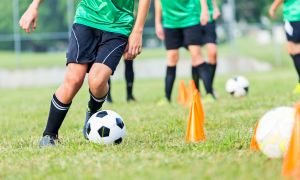Advertisement
Training frequency is determined by many different factors.
Age – most younger children will train for their sport a couple of times per week and play once per week in season. As you get older your involvement in the sport becomes more serious then so does the time commitment, often needing to practice up to x4 per week and playing at least x1 per week in season.
Playing level – it is not uncommon for professional athletes to train everyday for most of the year, even a day off may include some light recovery type session such as a massage or stretch.
Phase of season – during the off-season players usually have a period of down time and are encouraged to engage in light physical activities away from their focus sport. They then engage in serious physical preparation in the latter part of the off-season in readiness for the pre-season training camps. During pre-season players combine their physical preparations with the technical and tactical components, usually training x2 per day for 6 days per week. Once the season starts competition takes centre stage and players may train less in order to be fresh to compete.
Age – most younger children will train for their sport a couple of times per week and play once per week in season. As you get older your involvement in the sport becomes more serious then so does the time commitment, often needing to practice up to x4 per week and playing at least x1 per week in season.
Playing level – it is not uncommon for professional athletes to train everyday for most of the year, even a day off may include some light recovery type session such as a massage or stretch.
Phase of season – during the off-season players usually have a period of down time and are encouraged to engage in light physical activities away from their focus sport. They then engage in serious physical preparation in the latter part of the off-season in readiness for the pre-season training camps. During pre-season players combine their physical preparations with the technical and tactical components, usually training x2 per day for 6 days per week. Once the season starts competition takes centre stage and players may train less in order to be fresh to compete.
Sport-specialized training can be a year round endeavor in some cases. As in every sport, practicing your craft 6 days a week while in-season is pretty standard. It's always a wise policy to take off at least one day a week to rest and recover if scheduling permits. As the off-season transforms into pre-season, more time must be spent practicing the actual sport and creating high levels of competency and coordination for the skills needed for success. Different sports require different time commitments, so it is sometimes too difficult to give an exact number. When balancing between sports performance training and training sports skills, the relationship is usually inversely proportional with respect to time prior to competition. For example, at the beginning of an off-season, spend more time performance training (resistance training, focusing on conditioning) and less time practicing sport skills. As the season draws closer, balance your time and energy evenly between the two. When entering the pre-season, you should primarily focus on sport skills and technique while giving less time to sports performance training.
Continue Learning about Sports & Athletic Performance
Important: This content reflects information from various individuals and organizations and may offer alternative or opposing points of view. It should not be used for medical advice, diagnosis or treatment. As always, you should consult with your healthcare provider about your specific health needs.


